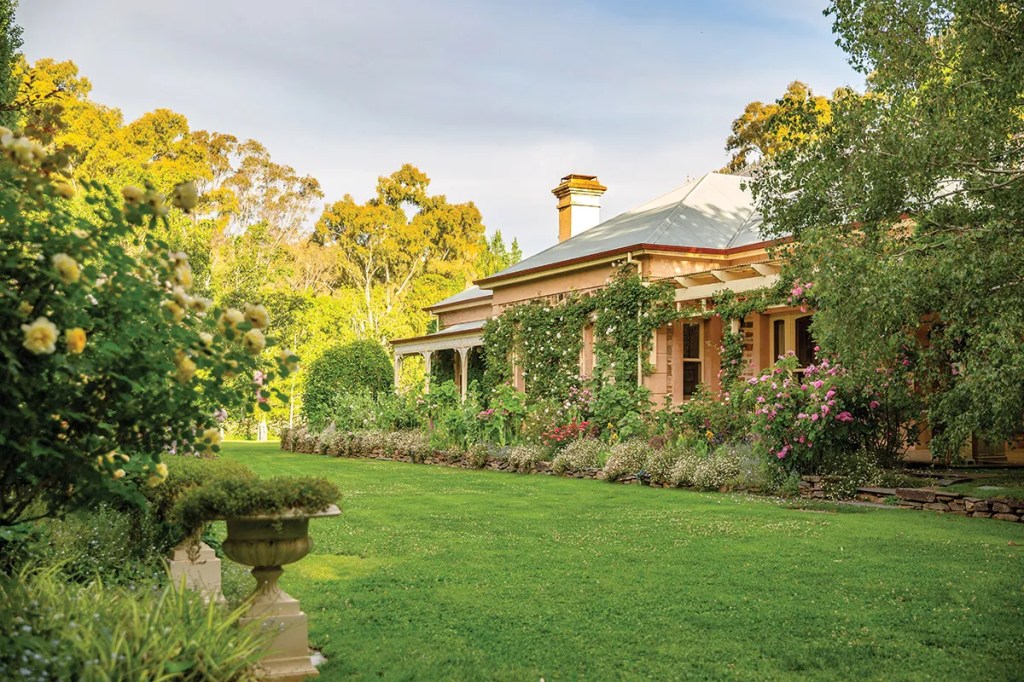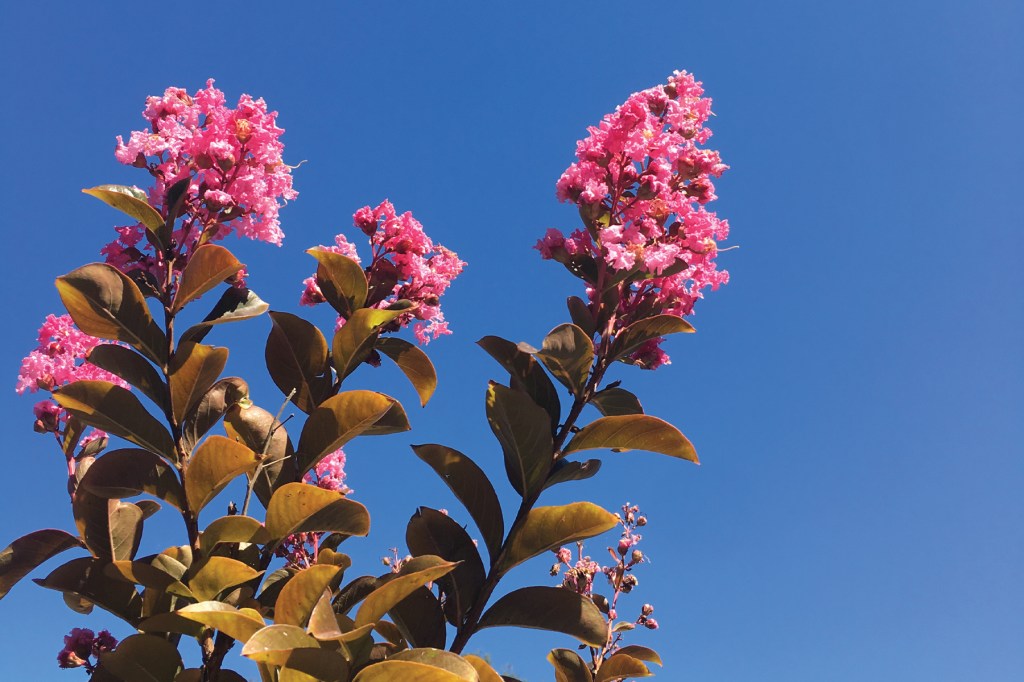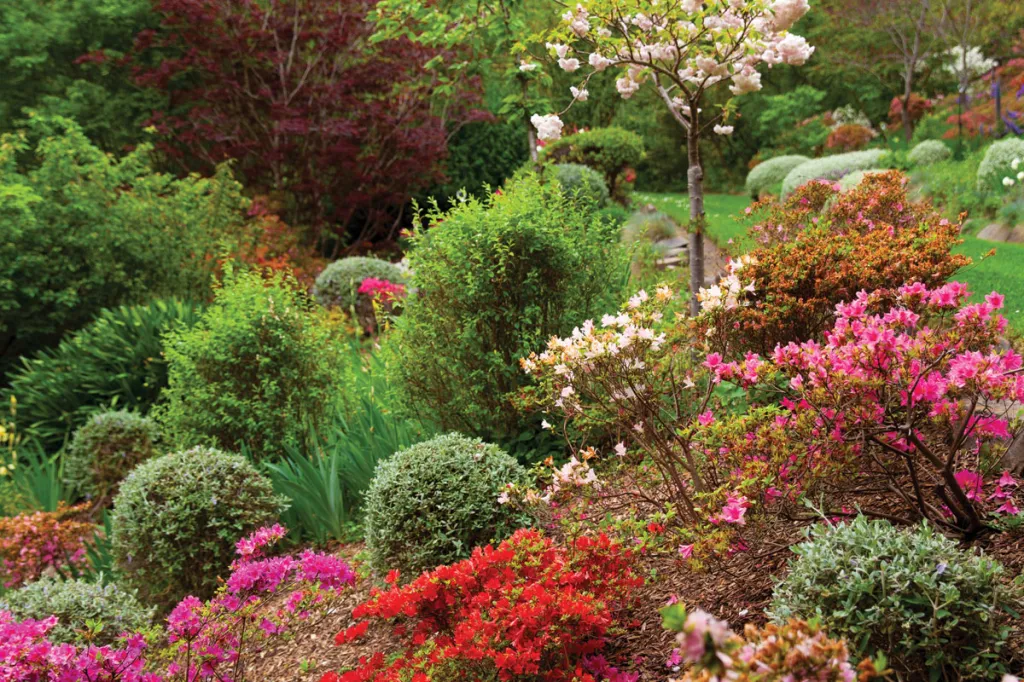
Words and photographs Ben Kelly
Golden tendrils of sunset infiltrate gaps in the foliage of giant trees surrounding Kay and Walter Duncan’s bluestone home at Sevenhill, casting long orange rays across the manicured lawns and igniting blooms of roses in lush garden beds.
The roses are in full flight when SALIFE visits The Heritage Garden on a warm spring evening in the Clare Valley. Twenty arches of fragrant Bourbon roses guide visitors down the garden path which leads into expansive plantings of old-world roses that emanate fragrant aromas. Garden beds around the bluestone villa swim with colourful blooms of annuals.
“I’m 84 this December and I still go out into the garden every day; I think it keeps you young,” says Walter. The octogenarian uses a mobility scooter to zip around the many garden paths, with Teddy the Jack Russell in tow. His wife Kay works in the garden daily and while Walter still does a spot of pruning, it’s his sharp horticultural mind that he puts to work overseeing management of the property.

Over 25 years, Walter and Kay Duncan have invested enormous energy into creating an incredible garden across eight hectares.
The Heritage Garden is a testament to the work ethic and horticultural nous of Walter and Kay, who moved here 25 years ago. Their bluestone villa, which looks as if it has been in situ for a century, is in fact Walter’s family home that he and Kay transplanted from Adelaide’s eastern suburbs. The home was in disrepair and so Kay and Walter had it demolished and trucked up to Clare, where it was rebuilt anew.
Walter’s life has not all been a bed of roses, but the rosarian has steered through life’s thorny patches with incredible work ethic, a trademark sense of humour and disarming ability to “smooth people out a bit”, while being supported by Kay and the horticultural community.
Growing up in Eastwood, Walter’s foray into horticulture began early, thanks to his mother Rosemary who, of course, adored roses. Walter was growing and selling silver birch trees by the age of 13.

Many brides have walked down The Heritage Garden’s row of arches, planted with repeat flowering Bourbon rose, Souvenir de la Malmaison.
“I started growing roses when I was 15 and it largely occurred because I broke my arm playing football. It was in plaster, and I couldn’t move it,” says Walter. “Mum said to me, ‘You’re not going to sit around the house, I’m taking you down to learn to prune. You can prune with your good hand’.”
By his early 20s, Walter had become vice president of the Rose Society of South Australia – unheard of for someone so young. In 1972, he became the society’s youngest-ever president. He was made an honorary Life Member in 1978.
Walter’s parents were closely connected to renowned painter Hans Heysen and Walter’s childhood involved trips to The Cedars every so often. Once he began growing roses, Walter would take blooms to the Heysens, and this started a friendship that spanned many years. Both Hans and his daughter Nora took a liking to Walter.

Walter started gardening at a young age.
“He (Hans) sent me a drawing every Christmas,” says Walter. “Nora was great too – she was a good stick.”
On one occasion, Nora was having trouble painting a bunch that she had arranged herself and sighted Walter and his blooms. She seized his roses and began painting his flowers, saying: “You can leave the roses with me … leave Walter as well!” From that time, Walter regularly took blooms to Hahndorf for Nora to paint, and later sent them to her Sydney studio. She would reply with letters.
Over the years, and as Hans grew older, Walter would visit almost every fortnight and spent hours with the great artist. In return, Walter gleaned a deep understanding of what roses could mean to other people. The greatest lesson he learnt from Hans was how to see things in people and nature as they really are, and not to merely look at them.

A pathway leads from the garden into the quince orchard.
The bulk of Walter’s career was spent developing a large production rose nursery on his great-aunt’s pastoral property at Watervale, named Hughes Park. The farm and its buildings were in disrepair when Walter started there, but he and his previous wife undertook the huge task of restoring the house and land. “I straightened up that garden too,” says Walter.
Walter became a student of rose growing and learned from the best in the industry. People such as rose grower David Ruston and, later, foremost English rose budder Vic Groves. His business, The Rose Garden, grew exponentially and produced 100,000 roses a year to supply retailers around the country. Things became difficult for Walter after a divorce, and with so much work to do, but he was supported by his team at The Rose Garden.
Kay and Walter first met over the phone in the 1990s. Kay phoned The Rose Garden looking for a job and Walter answered. “We chatted for a while and he said, ‘well, you can start on Monday’,” remembers Kay. “I said, ‘what will I be doing?’ and he said, ‘you’ll be stripping’ – meaning stripping the canes of roses. Something in his voice told me he had a sense of humour, so I replied: ‘but you haven’t seen my body yet’. I got the job.”

A Pierre de Ronsard rose.
Walter’s ability to look at the funny side of life has a softening effect on others. “It is the only way to survive – when everything goes haywire you’ve got to be able to laugh at it,” he says. Kay is equally as passionate about gardening as Walter and the pair has been a perfect coupling.
In 1999, Walter and Kay were driving through Sevenhill where they drove past a For Sale sign on a property lined with magnificent gum trees. Needing to move Walter’s business, The Rose Garden, to a new location, and looking for a new home, they bought it.
At the same time, Walter and his brother Jock needed to sell their parents’ run-down bluestone villa at Eastwood. Walter and Kay decided to demolish the bluestone home and rebuild it up at Sevenhill. The couple project managed the entire process. “The house looks like it’s been here for a century and in the early days, people couldn’t believe we had built it,” says Kay.
The Sevenhill property was in a “dreadful” state, but Kay and Walter went about building their garden. “It was very much about laying out hoses and marking it out, leaving it and thinking about it, and then doing it again until we were both happy that it was right,” says Kay.
“We got it pretty right,” says Walter.

Once part of Walter’s rose nursery, The Heritage Garden’s French rose section is awash with pink blooms of Paul Bocuse roses.
Subscribe for updates
They were assisted by workers from Walter’s rose nursery business. Leftover bluestone from the demolition of the house was used for retaining walls for garden beds. Roses were surrounded with quick-growing plants such as lavender and rosemary. Lamarque roses were planted up the verandah posts, interweaving the home into the garden.
Walter brought his production nursery across to Sevenhill, planting 100,000 roses on the new property, but he wound that up after a few years. His business partner took the rose nursery elsewhere, so The Heritage Garden became Walter and Kay’s private home.
A legacy of Walter’s former rose business is a spectacularly large garden of French roses planted to the western end of the property. This garden is a magnificent display of historic roses from the French rose breeder Jean Pierre Guillot. The garden is a living testimony to Walter’s friendship with Jean Pierre who gave Walter the rights to distribute his roses in Australia. They are a sensory delight when in bloom.
“Those roses are great for perfume, for height and for colour. They have great flowering ability, and they suit our climate up here,” says Walter.

The tubular purple flowers of foxgloves pop up from lush garden beds.
Once, after hearing Maggie Beer speak about her difficulty to source quinces for her products, Kay and Walter planted a large quince orchard of 200 trees, which supplied Maggie Beer and later Beerenberg.
The most recent addition to the garden is a labyrinth, spiralling outwards from a central point. Young shrubs and grasses will in time grow to about one-metre high.
The Heritage Garden exists for people to enjoy through weddings, funerals and open days; the latter raising funds for the Royal Flying Doctor Service and Women’s and Children’s Hospital. The property’s refurbished stone cottage is now run as a bed and breakfast.

“We got it pretty right,” says Walter of he and Kay’s mission to create their dream garden.
Having run their own open days for many years, Walter and Kay have decided to join the SA Open Gardens Scheme in 2024, with the intention to open their garden in spring.
Walter’s work has had a lasting impact on South Australia. Not only are his roses spread across home gardens far and wide, but his roses are still growing strongly in many of Adelaide’s public gardens. Walter designed the old rose section of the Adelaide International Rose Garden and was involved in developing the rose gardens of Carrick Hill.
Walter and Kay travelled to Vancouver where Walter was bestowed a World Rose Award for his contribution to the rose industry; another of a long list of accolades he has accumulated over his lifetime. “Medals are handy things, you put them in a drawer and never see them again,” laughs Walter.

Lamarque roses grow up the verandah posts, interweaving the home into the garden. When the home was demolished and transported to Sevenhill, leftover bluestone was used to create retaining walls and steps.
Kay says the couple often get visitors asking for help with their roses. “There’s no point in closing the garden up and just keeping it for ourselves,” says Kay. “People who are passionate rose growers like to see the heritage roses in situ. You can’t always grow old world roses in the backyard of a suburban block, but here they’re allowed to grow large and do their own thing.”
For Walter, being a rosarian is not so much an occupation as a way of life. He has lived and breathed the world of roses. “It’s been a good innings, and I tell you what, the two of us didn’t muck around,” says Walter. “Some of it, you’d think we’d have been mad to do it, but we were mad, and we did do it.”
The Heritage Garden is a labour of love that Walter’s mother Rosemary would be incredibly proud of if she could see it now. Kay hopes The Heritage Garden will provide inspiration for other gardeners to take ideas and implement them in their own spaces.
As for Walter: “as long as it makes people happy, it’s been worth it”.
This article first appeared in the December 2023 issue of SALIFE magazine.

